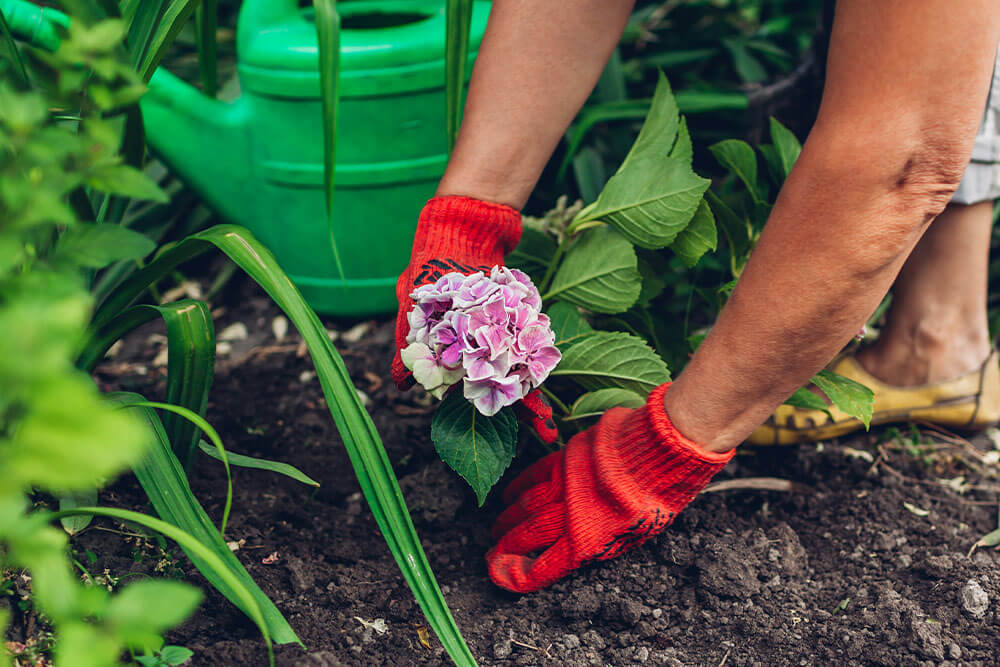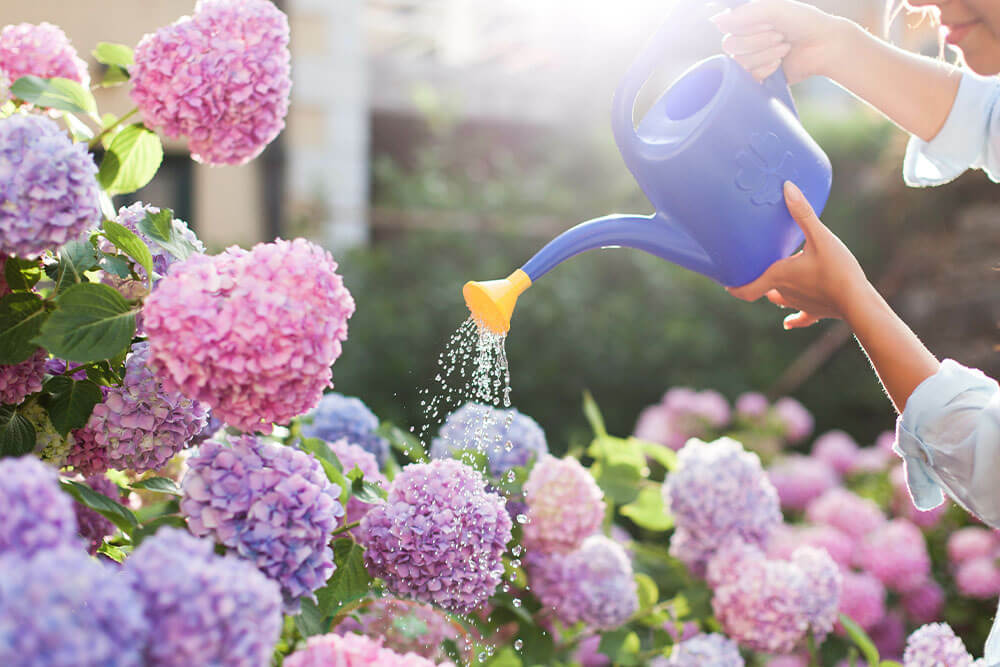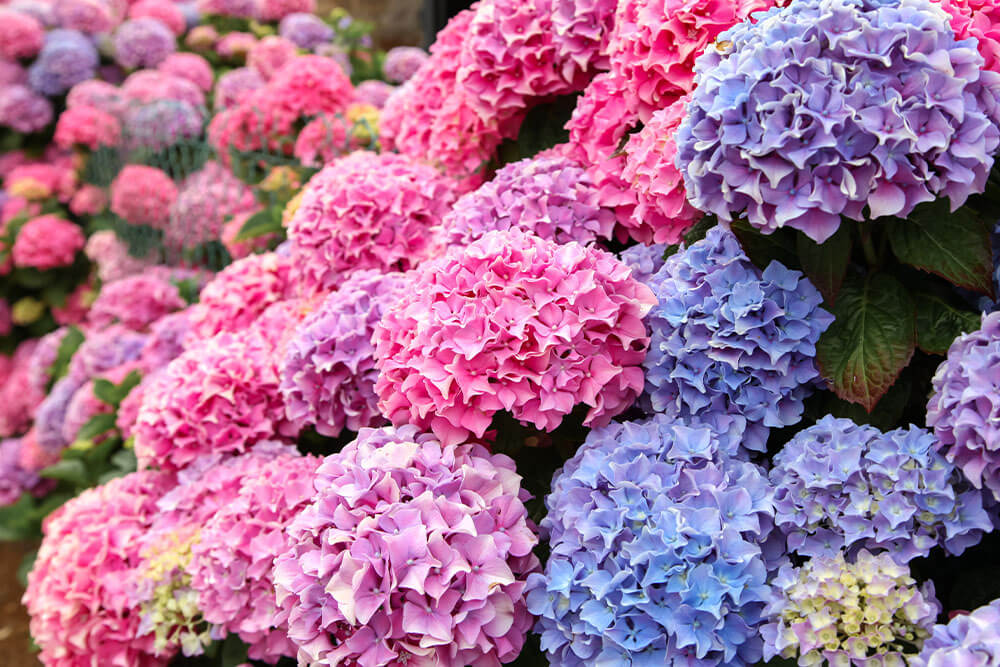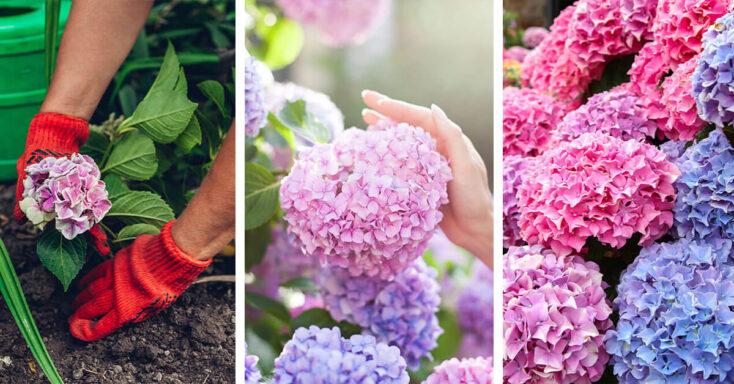Outdoor hydrangeas are striking and showy in your landscape, which is why they are among the favorite garden plants. Long-lasting, glorious blooms. Thick, vibrant foliage. And a disease-resistant plant to boot. What’s not to love? You can enjoy these flowers, too, by learning how to grow and care for outdoor hydrangea.
What is hydrangea?
The traditional hydrangea flower looks a bit like a pom-pom, so it’s only apt that they evoke cheer. It’s a charming plant, and you can learn how to change a hydrangea’s color with a little gardening finesse. In the United States, there are dozens of types of hydrangea from which to choose. The three most popular are bigleafs, smooth, and panicle hydrangeas.
Rumors have it that hydrangeas stump gardeners in terms of having a healthy, full-blossoming plant. Yes, they’re a little fussy. But when you buy a hardy plant and put it in the right spot, hydrangeas are sure to delight.
Key Takeaways
- You can prune hydrangeas to shape them. Just get to know your plant. Some hydrangeas prefer a spring clip, while others in winter.
- By making minor alterations in your soil, you can change a hydrangea’s color.
- Plant your hydrangeas in the fall. By so doing, your plant can focus energy on developing roots before the active growing spring season.
- If you have a space in your yard that receives morning sun and afternoon shade, that is the ideal placement for hydrangeas.
Misplaced Petals? At first glance, you might think hydrangeas have a plethora of petals. In truth, what you are seeing are sepals. These tiny leaves protect the flower bud. At first, sepals are green and eventually turn pink, purple, or blue, which you cannot help but notice.
Varieties of Hydrangea
When you shop for hydrangeas, all your options might astound you. Let’s look at a few.
- All Summer’s Beauty: This is a compact plant that gifts you with long-blooming, big flowers. They grow about 4 feet tall. Unlike some other cultivars, All Summer’s beauty buds in spring, summer, and fall (June to September.) It produces light blue, nearly lavender blossoms.
- Annabelle: If you like big (really big) flowers, Annabelle is for you. It produces pale white flowers up to 1 foot in diameter. Everything about this plant screams “classic.” With blossoming living until winter, this plant takes center stage in your garden.
- Climbing Hydrangea: If you have limited space in your garden, a climbing hydrangea may fill in as a backdrop. The leaves measure 2-4 inches, and the flower clusters are 6-10 inches (wow!). You have to be patient with these. It takes about 4 years before they start to produce tiny white flowers.
- Coerulea: A healthy plant with a posy-like array. The center flowers are deep blue, then white flowers frame the blossoms. Blossoms from May until the first hard frost.
- Endless Summer®: This Hydrangea grows between 3-5 feet and comes in blue, pink, purple, red, and white. Endless Summer is a knockout flower erupting from top to bottom throughout the growing season. Butterflies like this plant.
- Glowing Embers: This plant can be somewhat square in that it grows upward and outward to 3-5 feet. The rich burgundy purple can be up to 9 inches across (sometimes the flowers are a deep rose). It’s a compact hydrangea, perfect for smaller spaces.
- Haas Hallo: The flowers on this hydrangea look lacy and fairy-like. The flowers are quite handsome, measuring 14 inches in diameter. Mature height: 3-5 feet. Blossoming time: July to September. A perfect landing pad for pollinators.
- Invincibelle® Spirit II: A sea of pink dome-shaped petals. The flowers measure 6-8 inches. Blossoms come in summer and well into fall. Mature height: 3-5 feet.
- Grandiflora: There is something wholly endearing about the Grandiflora. It’s not what you would call a “uniform” plant. They’re somewhat clumpy. This plant can grow up to 15’ tall. Grandiflora boasts dark green, oval leaves and flowers measuring 6-8” in diameter.
- Next Generation® Pistachio: These unusual flowers cut a fine portrait having raspberry fuchsia blossoms edged in emerald. This hydrangea gifts you with continuous flowers from spring to late fall.
- Nikko Blue: a mophead, periwinkle blue blossom (that also comes in white, pink, and purple). This is a fast-growing hydrangea, adding two feet to its height annually. Mature plants are 6-10 feet tall.
- Peegee: You can keep this hydrangea as a large shrub (10-15 feet) or a good-sized tree (25 feet tall). Make sure you have space! The Peegee has cone-shaped clusters that are initially white. Over time, they turn pink or purple. They blossom from late summer to early fall.
- Pinky Winky: A hydrangea with a flower as unique as its name. As the white florets fade, new pinkish-red ones form at the bottom of the panicle, producing a tiered effect. By late fall, they are fully pink.
- Variegata: A shrub that grows 3-6 feet tall. Depending on the plant, the flowers can be pink or blue. The most interesting asset for Variegata is the leaf margins that turn white, creamy, or even somewhat gold.
Truthfully, the study of hydrangea cultivars could easily fill a book.
Warning: Toxic
Hydrangeas are highly poisonous because of cyanide compounds in the leaves. Keep this in mind when you’re placing your plant. Keep it far away from pets and children’s reach.
When to Plant Hydrangeas?
The consensus is that you should plant hydrangeas in autumn. Because the plant is no longer blossoming, it can turn its energy resources into building its root system. For those who experience long, cold winters, plant them early in the fall. If you live in a dry environment, continue watering plants in the fall and winter.
If something precludes you from planting in the fall, you can put them in the ground in early spring. Just avoid waiting until summer. Also, it helps if you plant hydrangeas on any day before it gets hot.
It’s Greek to Me: The word hydrangea comes from Greek. “Hudro” means water. “Angeion” translates as vessel (because of the cup shape of the seed capsule. The “hudro” part is particularly apt. Hydrangeas need a lot of water to thrive.
Where to Plant Hydrangeas?

Take a day to watch where sunlight hits your yard. Most hydrangeas like a balance between the shady afternoon and morning sun. Noon is just too hot for their leaves.
One area where they seem to look stunning is against the house. The house walls offer shelter. Pick a color that works with your paint themes.
Soil Requirements
If there’s a spot in your yard, that’s always muddy, that is not a place for hydrangeas. It requires well-drained soil. You may have to dig up some ground and give it rich organic matter. Once in the ground, you can deter weeds by using mulch on top of the soil. Give it a deep watering right after getting the hydrangea settled.
Perfecting pH
A little tinkering with the pH of your soil can change hydrangea’s color. It helps to get a soil test first, or you could be flying blind. If you want a blue hydrangea, you need slightly acidic soil (5.0-5.5). For pink or purple blossoms, you want a 6.0-6.5 pH.
When your plant is already blue, and you want it pink or purple, garden lime can help up the pH level. Don’t expect immediate results, however. It will take several weeks, and sometimes months, before you’ll see the transformation.
Factoid
White hydrangeas usually don’t change color when the pH of the soil goes up or down. They’re not the only ones. Certain hydrangeas like Cape Hatteras and Fire Island stick to their original colors like glue.
To move your hydrangea into the blue zone, peat moss, and coffee grounds make excellent amendments.
Companion Planting
When we look at companion planting, there are beneficial partnerings and ones that end in disaster. No matter how pretty they may look, some plants do not play well with others. When there are differences in light, water, and soil requirements, you’re bound to run into problems. Lavender is an example of a flower that’s stunning with hydrangeas, but lavender likes poor-quality soil that’s dry. Your hydrangea will go on strike.
English ivy is very invasive, and it can quickly take over your hydrangea space. The ivy’s shallow root system means it competes with hydrangea for nutrients in neighboring soil. Both plants are hungry for nitrogen and potassium. Both parties cannot win. Azaleas are similar, with shallow roots that go hunting for rich organic matter.
Having black walnut trees growing near your hydrangea can stunt their growth because of a compound produced by its roots (juglone).
Hydrangeas cannot tolerate juglone. Keep your hydrangea at least 60 feet from the tree’s trunk.
On the other hand, think rhododendrons! They love hydrangeas, and the feeling is mutual. Both like a bit of shade, slightly acidic soil, and organic mulch.
Hostas are another exciting combination, classic to the garden. Hostas thrive around the base of hydrangeas. Both plants like partial shade. The benefit of planting hostas with hydrangea is they help deter weeds.
Significance of Hydrangeas in Japan: In Japan, hydrangeas have several meanings. They represent gratitude, understanding, thankfulness, and honest emotions. One legend says a Japanese emperor gave the woman he loved hydrangeas as an apology for getting so caught up in business he neglected her. Another reason for hydrangea’s significance is because ancient emperors gave them to their maidens to thank them.
Caring for Outdoor Hydrangeas

Two more elements of outdoor hydrangea care are fertilizer and water.
Fertilizer
A well-balanced fertilizer in spring suits hydrangeas just fine. Combine this with a layer of compost mixed with mulch. Just remember:
- Bigleaf fertilization should happen three times during the growing season. The first comes in early spring.
- Oakleaf hydrangeas appreciate fertilization twice. Once in spring and the other in early summer.
- Smooth hydrangea benefits from one application of fertilizer in early spring or late winter.
Water
The best rule of thumb is to water your hydrangeas first thing in the morning before the sun heats up. The night isn’t a good option. As the temperature cools, the dam encourages mold or mildew. Always water at the base of the plant, not over the foliage.
When established, water your hydrangea when the soil dries (down to an inch). Always test first. You don’t want to over water. Hydrangeas can get soggy, and they do not handle that environment well.
Sniffles be Gone! Hydrangeas have a unique trait. Their pollen is very sticky. So when wind bats them around, the pollen (for the most part) stays in place. Then there’s the fact that hydrangeas have no fragrance. What a great choice for gardeners who are allergy-prone.
Deadheading Hydrangeas
In the truest sense of the word, deadheading is not pruning. Instead, it’s removing spent flowers and tidying up the plant greatly. It is not necessary to deadhead for the health of your hydrangea.
Leave the flowers in place as long as possible. Then cut right above the set of leaves just below the flower. Do not cut any further. There could be buds emerging!
Get rid of stems with no new leaves. Trim at the base, give the plant more air, and let it focus on growing.
Pruning
A great number of hydrangeas really don’t need pruning but for shaping them to your liking. You can most certainly cut away dead pieces. Keeping it clean results in lush flowers.
There is a trick to pruning. Wait to prune smooth hydrangeas in late winter or early spring. Panicle hydrangeas have a similar timeline. Prune your bigleaf hydrangeas at the end of the bloom period, and similarly wait until after flowering for mountain hydrangeas.
If you’ve got a repeat bloomer, don’t prune but for faded flowers and dead branches.
Shape Up!
There are three shapes of hydrangeas. The mophead is the one with which you’re most familiar, growing in the shape of a pom-pom. Lace cap hydrangeas have petite flowers growing in clusters. These have an old-world feel to them. Finally, the panicle looks like an ice cream cone of petals.
Wintering
While you’re doing your fall cleanup, guess what? You can leave your hydrangeas alone. There is no reason to cut them back for winter.
The bad news is that there are some steps you should take to protect your hydrangeas (if you live in an area with cold winters). Hydrangeas don’t like sudden changes, but there are simple ways to help your plants.
- First, keep watering your outdoor hydrangeas until the first freeze. If you have rainy winters, water deeply, but not as often as during the growing season.
- Second, amend the soil with compost. It feeds your plant through the winter season. Better still, it breaks down over the months, so the soil is already prepared for hungry spring plants.
- Third, in some ways, mulch is like a hydrangeas blanket. Having it around the plant protects the roots from extreme temperature changes. If you live where it’s warm, use mulch anyway. It’s an idea for keeping the weeds out.
- Speaking of blankets, you can wrap your hydrangea with burlap for another level of protection. Roll out two turns of the burlap and secure it with twine.
Hydrangeas on Holiday: Hydrangeas rank high in popularity in the United States. In fact, they have their own holiday.
Hydrangea Day takes place every January 5th. While the timing for the event seems “off.” Nonetheless, some aficionados keep plants for showing on just such occasions.
Hydrangea Pests and Diseases

Every plant has an Achilles heel (um root?) or two. Hydrangea is no exception.
Disease
Are you seeing small water-soaked spots on your hydrangea? If they turn brown shortly thereafter, you probably have Botrytis Blight. Another sign is gray fungus appearing on the flowers. Treat it as you would powdery mildew.
Cercospora is a leaf spot disease that’s relatively common. Keep wetness off the plant’s leaves. A fungicide may be necessary. Remove all the affected leaves.
Bigleaf hydrangeas get the most serious cases of powdery mildew. It’s easy to see a powdery growth on leaf surfaces. It’s not terribly harmful, but it certainly doesn’t look pleasant. Try to reduce crowding around the hydrangea. Remove fallen leaves. If there’s a severe infection, look to horticultural oil.
Root Rot is a common nemesis on oakleaf hydrangea. When a plant becomes stressed, root rot may begin. Shoots start wilting. To be proactive, fertilize according to your soil tests. Make sure your plants have well-drained soil.
Insects
There are a couple of critters who find hydrangea very attractive. Aphids seek out new growth on this plant. Leaf yellowing and distortion are two signs. You might also notice a sticky clear coat on some leaves. The solution? Hose them down with a strong spray of water over several days. Spray past the plants so the soil doesn’t get soaked.
The black vine weevil gets into your hydrangeas’ roots. You’ll notice your plants turning yellow, then brown, and then dying altogether. Nematodes may control the issue or potentially chemical applications before egg laying begins.
Hydrangea leaftiers are noticeable on your plant. It really doesn’t hurt the hydrangea, but potentially lowers flower output. You may see caterpillar webs on your leaves, looking like tents. You can remove these by hand.
Color-Coded Hydrangea
In floral symbolism, the color of hydrangea has a specific meaning. Pink petals say your feelings are true. Asians give this flower as an expression saying you hold their heart. Blue hydrangeas burst forward by way of apology. Purple hydrangeas mean you understand someone completely and wish to express desire.
Common Hydrangea Problems
If you’ve had a harsh winter, your hydrangea may be injured and won’t bloom. Check your soil for too much nitrogen.
Some other problems for your plants are not getting enough sun and shade, too much or too little water, and having healthy soil. You can over-prune your hydrangea or do it at the wrong time, so new buds are slow to form.
Celebrate: Traditionally hydrangea is a suitable gift on the fourth wedding anniversary. It expresses gratitude.
Summary
Hydrangeas are a colorful addition to any garden. Whether you choose big blossoms or tiny, each has a personality all its own. By knowing the type of hydrangea you have, you can learn how to grow it successfully and continue caring for it year after year. They’re perennials, going into hibernation in the winter so they can save up energy for those first dazzling spring flowers.
Frequently Asked Questions About Hydrangea Care
How do I keep my hydrangeas happy?
On the surface, hydrangeas look somewhat delicate. They’re really not, and even the simplest of things keep them happy. Give them 1 inch of water weekly in the growing season. Use soaker hose heads, keeping the spray of the leaves. Put mulch under your hydrangea to moderate moisture and heat. Check the instructions on your specific hydrangea about fertilizer, and follow that protocol.
Why are my hydrangeas dying?
There are any number of reasons your hydrangea is dying. First, check the moisture in the soil. Droopy plants mean your plant is thirsty. Second, check out how much sunlight they’re getting. Too much can burn them and lead to shock. If you see any obvious damaged parts on your plant, gently trim them out. They give them a good watering with compost to see if you can revive the plant.
Do hydrangeas need heat?
Certain types of hydrangeas have greater heat resistance. One excellent example is the panicle hydrangea. You can plant this in full sun, and it tolerates more dryness than most hydrangea. Other options include the Smooth hydrangea, which is accustomed to warmer environments. The Bigleaf hydrangea, both the lace cap and mophead, are among the most heat-tolerant hydrangea you’ll find. Panicle hydrangea handles the sun without complaint and oakleaf hydrangeas handle droughts well.
Do hydrangeas need to be cut back for winter?
There is really no reason to cut your hydrangeas back in winter. You risk the chance of removing flower buds that will open in the next season. Wait to prune your hydrangea in spring or summer after the flowers bloom.
Do hydrangeas need to be cut back every year?
Cutting back hydrangeas annually will help them produce more flowers. It cleans out dead leaves and stems, opening the plant to improved air circulation. This is the time to shape your plant to perfection. To be sure of when it’s best to prune your hydrangea is by knowing your cultivar, and researching effective care.



